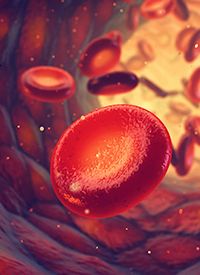Article
Venetoclax/Rituximab Combo Demonstrates Sustained Benefit for Retreated Patients with CLL
Author(s):
December 8, 2020 - The combination of venetoclax and rituximab to retreat patients with relapsed/refractory chronic lymphocytic leukemia demonstrated a sustained time to next treatment benefit according to 5-year follow-up data of the MURANO study in a poster presentation at the 2020 ASH Meeting.

The combination of venetoclax (Venclexta) and rituximab (Rituxan) to retreat patients with relapsed/refractory chronic lymphocytic leukemia (R/R CLL) demonstrated a sustained time to next treatment (TTNT) benefit according to 5-year follow-up data of the MURANO study in a poster presentation at the 2020 ASH Meeting.1 Additionally, treatment with the combination did not compromise subsequent therapy response or overall survival (OS) rates.
This analysis reported the response rates to follow-up therapy with venetoclax and venetoclax-based regimens, as well as exposure to Bruton tyrosine kinase inhibitor (BTKi) salvage therapy with patients who participated in phase 3 MURANO study (NCT02005471).
TTNT more than doubled in patients treated with venetoclax/rituximab (VenR; n =194) compared with those treated bendamustine/rituximab (BR; n = 195), with a median TTNT of 57.8 months (95% CI, 55.1–not estimable) versus 23.9 months (95% CI, 20.7-29.5), respectively (HR, 0.26; 95% CI, 0.20-0.35).1
At a median follow-up at 59 months, OS benefit was sustained among patients treated with VenR. The 5-year OS rates were 82.1% with VenR compared with 62.2% with BR. The median OS was not estimable in either arm (HR, 0.40; 95% CI, 0.26-0.62; P < .0001).1
“Five-year data from the MURANO study demonstrates that fixed duration venetoclax/rituximab in patients with relapsed/refractory CLL demonstrates time-to-next treatment benefit, improved time to second progression-free survival event, and high response rates to subsequent therapies including re-exposure or cross-over to venetoclax-based regimens,” said lead author Rosemary Anne Harrup, MD, a hematologist at Royal Hobart Hospital, in Tasmania, Australia.
Initial treatment with VenR was associated with improved time to a second progression-free survival (PFS) event. The survival benefit with VenR was not estimable versus 46.9 months (95% CI, 40.8-48.4) with BR (HR, 0.19; 95% CI, 0.12-0.29).1
In the MURANO, study patients were randomized to receive either VenR or BR. The primary end point was investigator-assessed PFS. Patients in either arm with disease progression were followed for OS and disease response to any subsequent anti-CLL therapeutic regimens.
The study demonstrated that the combination of VenR for 6 cycles followed by fixed duration for a maximum of 2 years improved outcomes compared to 6 cycles of BR. “[Early efficacy data from MURANO] established venetoclax plus rituximab as a standard of care for the treatment of patients relapsed/refractory CLL,” Harrup said.
In 2018, an optional retreatment cross-over substudy was added to the MURANO protocol. For this analysis, investigators collected data from both the cross-over study and outside the cross over for patients treated with venetoclax-based regimens or a BTKi.
This study of retreated patients was launched because of the limited data available to guide subsequent therapies when relapse occurs after fixed-duration of VenR and uncertainty regarding the efficacy of repeated treatment with this combination.
After a median treatment-free interval of 23.7 months (range 3.3–43.8 months), 32 venetoclax/rituximab patients were re-treated with venetoclax-based regimens; 21 were enrolled in the re-treatment arm of the MURANO sub-study and 11 were treated outside of the sub-study.
Following disease progression 67 patients treated with VenR and 123 patients treated with BR received subsequent treatment. Data for patients subsequently treated with a BTKi or a venetoclax-based regimen were included in the presentation.
Eighteen and 72 patients were treated with a BTKi, in the VenR and BR arms, respectively, with 14 and 56 patients experiencing a response. The best overall response rate (ORR) was for those in the VenR arm (100%) compared with the BR arm (83.9%). Specifically, 92.9% of patients in the VenR arm experienced a partial response (PR) or a partial nodal response and 7.1% had a complete response (CR) or CR with incomplete bone marrow recovery (CRi). The response rates for patients in the BR arm were 67.9% and 16.1%, respectively. Further, 10.7% and 5.4% of patients in the BR arm had stable disease and progressive disease, respectively.1
In total 32 patients from the VenR arm and 15 patients from the BR arm went on to receive venetoclax-based therapy and had 18 and 10 responders, respectively. The best overall response rate was 72.2% for those previously treated with VenR versus 80.0% for those previously treated with BR. The CR/Cri and PR/nPR rates were 5.6% and 66.7% for VenR and 30.0% and 50.0% for BR.
“This indicates that early use of venetoclax/rituximab over bendamustine/rituximab does not compromise efficacy of subsequent therapy,” Harrup said.
Of note, of the remaining patients in the VenR cohort, 22.4% of patients received subsequent chemoimmunotherapy and 3.0% received another unidentified therapy. In the BR cohort 19.5% of patients received chemoimmunotherapy and 9.8% received another therapy.
No new safety data was included in the presentation.
Reference
Harrup RA, Owen C, D’Rozario J, Robak T, et al. Efficacy of subsequent novel targeted therapies, including repeated venetoclax-rituximab (VenR), in patients (pts) with relapsed/refractory chronic lymphocytic leukemia (R/R CLL) previously treated with fixed-duration VenR in the Murano study. Presented at: American Society of Hematology Annual Meeting and Exposition; December 5-8, 2020; Virtual. Abstract 3139.






%20(2)%201-Recovered-Recovered-Recovered-Recovered-Recovered.jpg?fit=crop&auto=format)

%20(2)%201-Recovered-Recovered-Recovered-Recovered-Recovered.jpg?fit=crop&auto=format)
%20(2)%201-Recovered-Recovered-Recovered-Recovered-Recovered.jpg?fit=crop&auto=format)